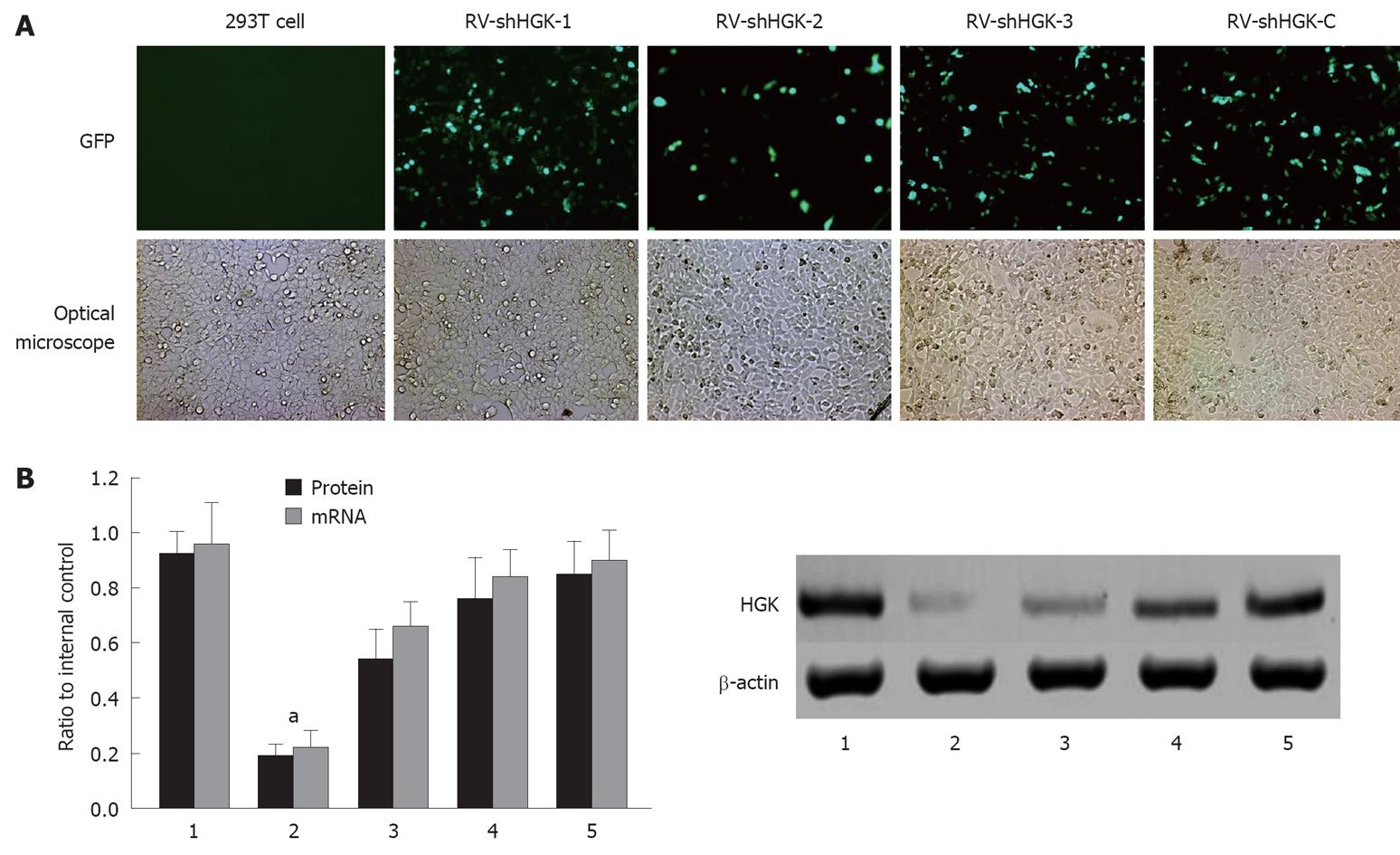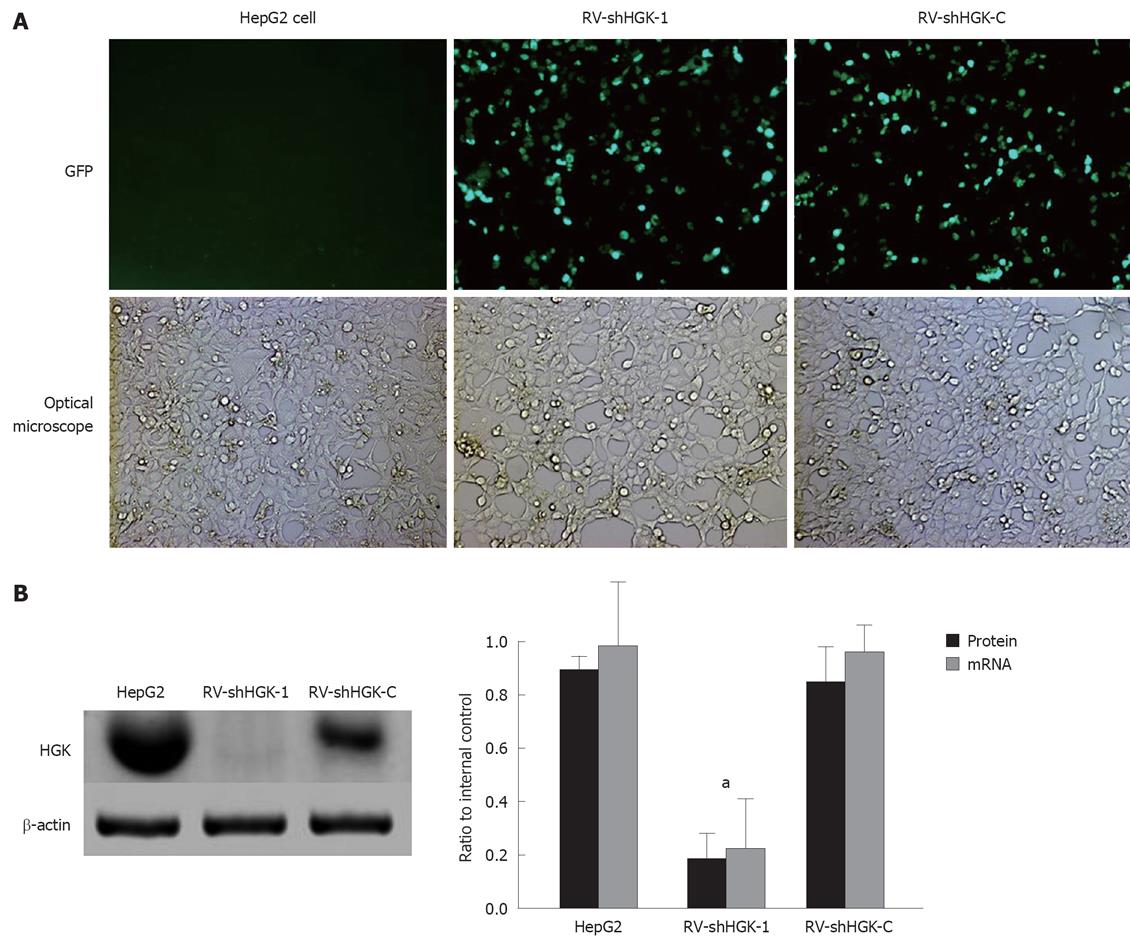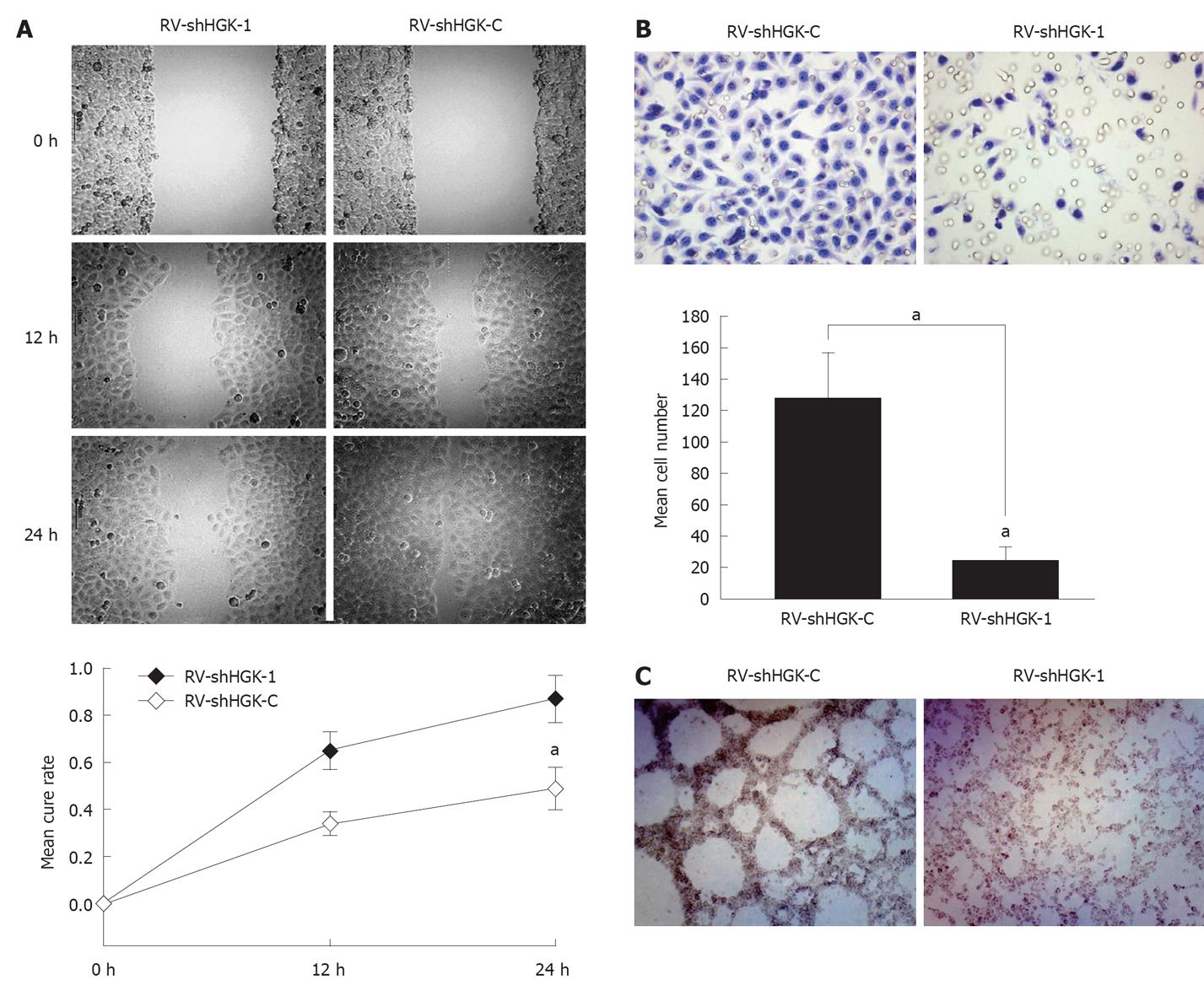Copyright
copy;2010 Baishideng Publishing Group Co.
World J Gastroenterol. Sep 28, 2010; 16(36): 4541-4548
Published online Sep 28, 2010. doi: 10.3748/wjg.v16.i36.4541
Published online Sep 28, 2010. doi: 10.3748/wjg.v16.i36.4541
Figure 1 Selection of the most effective hepatocyte progenitor kinase-like kinase specific shRNA expression vector in 293T cells.
A: Phase contrast and GFP expression under a fluorescent microscope after 48 h in 293T cells; B: Protein mRNA and hepatocyte progenitor kinase-like kinase (HGK) levels after HepG2 cells were treated with different vectors detected by real-time reverse transcriptase polymerase chain reaction and Western boltting assay. The vector retrovirus mediating RNAi targeting of HGK (RV-shHGK)-1 significantly inhibited HGK expression in HepG2 cells, aP < 0.05 vs HepG2 cells and HepG2 cells transfected with RV-shHGK-C vector. 1: 293T cells; 2: Transfection of RV-shHGK-1 vector in 293T cells; 3: Transfection of RV-shHGK-2 vector; 4: Transfection of RV-shHGK-3 vector; 5: Transfection of RV-shHGK-C vector (original magnification × 200).
Figure 2 Hepatocyte progenitor kinase-like kinase expression suppressed by RV-shHGK-1 retrovirus in HepG2 cells.
A: HepG2 cells infected with retrovirus mediating RNAi targeting of hepatocyte progenitor kinase-like kinase (RV-shHGK)-1 or RV-shHGK-C (multiplicity of infection = 4), GFP expression and the phase contrast images after 48 h (original magnification × 200); B: Protein and mRNA levels of hepatocyte progenitor kinase-like kinase (HGK) after HepG2 cells were treated with different retrovirus detected by real-time reverse transcriptase polymerase chain reaction and Western boltting assay. The retrovirus RV-shHGK-1 significantly inhibited HGK expression in HepG2 cells, aP < 0.05 vs HepG2 cells and HepG2 cells infected with RV-shHGK-C retrovirus.
Figure 3 Down-regulation of hepatocyte progenitor kinase-like kinase inhibits HepG2 cell growth and adhesion (methyl thiazolyl tetrazolium assay).
A: HepG2 cell growth was significantly suppressed by retrovirus mediating RNAi targeting of hepatocyte progenitor kinase-like kinase (RV-shHGK)-1 vs RV-shHGK-C group; B: RV-shHGK-1 inhibited HepG2 adhesion to fibronectin (FN), laminin (LN) and collagen IV. aP < 0.05 vs control.
Figure 4 Down-regulation of hepatocyte progenitor kinase-like kinase inhibits HepG2 cell invasion.
A: HepG2 cell invasiveness was significantly suppressed by retrovirus mediating RNAi targeting of hepatocyte progenitor kinase-like kinase (RV-shHGK)-1 vs RV-shHGK-C group (original magnification × 200, aP < 0.05); B: The blue-stained cells are those invading the ECMatrix and migrating through the polycarbonate membrane to the lower surface of the membrane (original magnification × 200, aP < 0.05 vs HepG2 cells infected with RV-shHGK-C); C: HepG2 cells infected with RV-shHGK-1 do not form the structure patterned network of interconnected loops (original magnification × 200).
Figure 5 Hepatocyte progenitor kinase-like kinase, matrix metalloproteinase-2, matrix metalloproteinase-9 and nuclear factor-κB expressions in HepG2 cells (Western blotting).
A: Retrovirus mediating RNAi targeting of hepatocyte progenitor kinase-like kinase (RV-shHGK)-1 significantly inhibited matrix metalloproteinase (MMP)-2, MMP-9 and nuclear factor (NF)-κB in HepG2 cells. MMP-2 protein expression in each group (Western blotting); B: Densitometric analysis hepatocyte progenitor kinase-like kinase (HGK), MMP-2, MMP-9 and NF-κB protein expression in HepG2 cells infected with RV-shHGK-1 or RV-shHGK-C, respectively. aP < 0.05 vs HepG2 cells infected with RV-shHGK-C.
- Citation: Han SX, Zhu Q, Ma JL, Zhao J, Huang C, Jia X, Zhang D. Lowered HGK expression inhibits cell invasion and adhesion in hepatocellular carcinoma cell line HepG2. World J Gastroenterol 2010; 16(36): 4541-4548
- URL: https://www.wjgnet.com/1007-9327/full/v16/i36/4541.htm
- DOI: https://dx.doi.org/10.3748/wjg.v16.i36.4541













